Effective Management Skills and Practices at Microsoft
VerifiedAdded on 2023/06/10
|9
|2638
|103
Report
AI Summary
This report provides a comprehensive analysis of management skills, focusing on their importance within organizations, particularly Microsoft. It explores various types of management skills, including planning, communication, delegation, and problem-solving, and their application within the company. The report delves into key principles related to managing and developing people at Microsoft, such as training and development, aligning cultures and values, encouragement, total rewards, and diversity and inclusion. It also examines the importance of diversity in the workplace, highlighting its impact on productivity, creativity, global reputation, and company culture. Furthermore, the report discusses various theories of motivation, including Maslow's Hierarchy of Needs, Herzberg's two-factor theory, McGregor's Theory X and Y, and Equity Theory, and their relevance to Microsoft's management approach. Finally, it explores decision-making and problem-solving theories and their application within the company, offering insights into Microsoft's strategic approaches to these critical aspects of management.
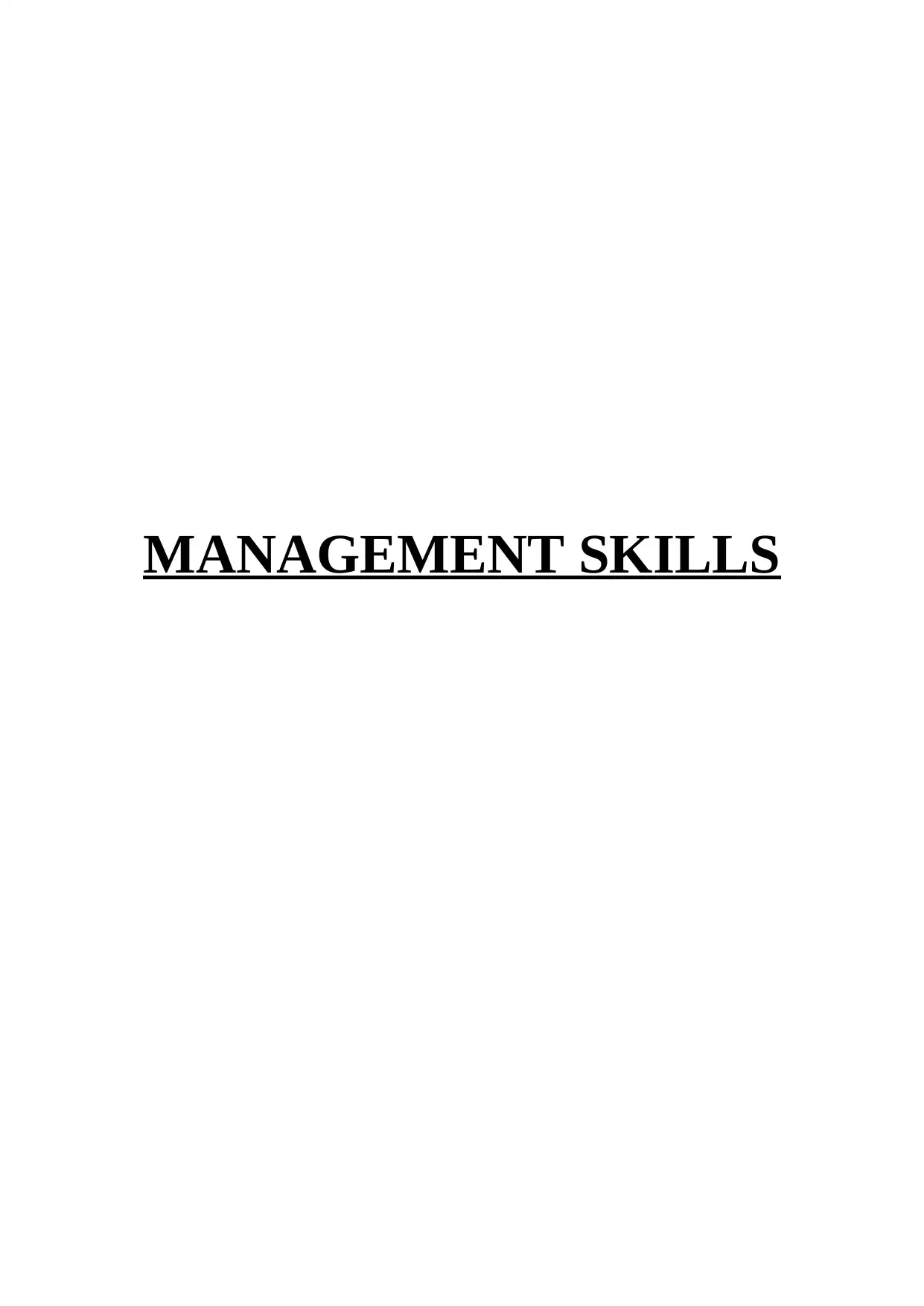
MANAGEMENT SKILLS
Paraphrase This Document
Need a fresh take? Get an instant paraphrase of this document with our AI Paraphraser

Contents
Introduction...........................................................................................................................................3
Main body.............................................................................................................................................3
Importance of management skills......................................................................................................3
Key principles related to the management and development of people in Microsoft.........................4
Importance of diversity in an organization........................................................................................5
Theories of motivation within the organization.................................................................................5
Theories of decision making and problem solving in Microsoft........................................................7
Conclusion.............................................................................................................................................8
References.............................................................................................................................................8
Introduction...........................................................................................................................................3
Main body.............................................................................................................................................3
Importance of management skills......................................................................................................3
Key principles related to the management and development of people in Microsoft.........................4
Importance of diversity in an organization........................................................................................5
Theories of motivation within the organization.................................................................................5
Theories of decision making and problem solving in Microsoft........................................................7
Conclusion.............................................................................................................................................8
References.............................................................................................................................................8
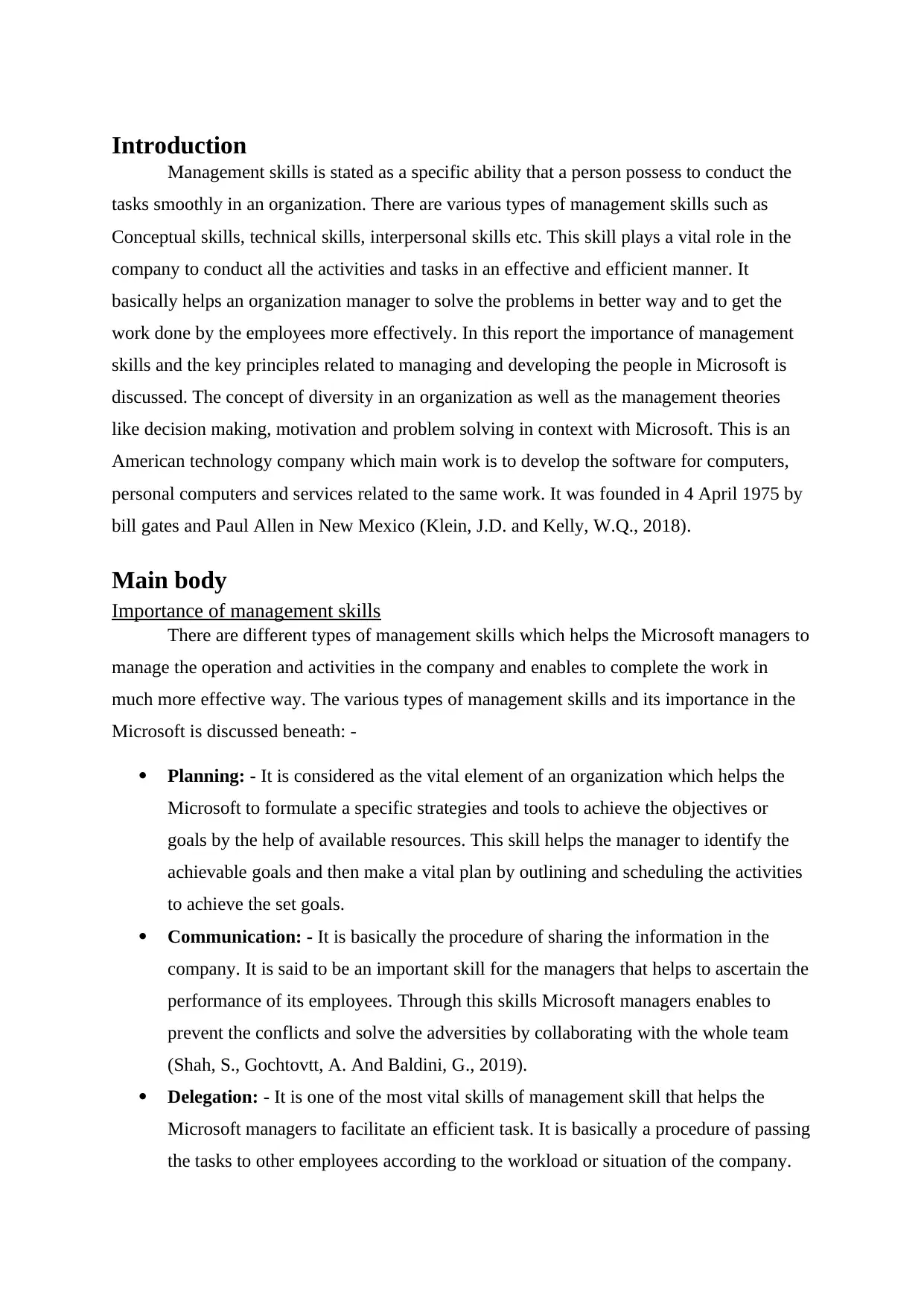
Introduction
Management skills is stated as a specific ability that a person possess to conduct the
tasks smoothly in an organization. There are various types of management skills such as
Conceptual skills, technical skills, interpersonal skills etc. This skill plays a vital role in the
company to conduct all the activities and tasks in an effective and efficient manner. It
basically helps an organization manager to solve the problems in better way and to get the
work done by the employees more effectively. In this report the importance of management
skills and the key principles related to managing and developing the people in Microsoft is
discussed. The concept of diversity in an organization as well as the management theories
like decision making, motivation and problem solving in context with Microsoft. This is an
American technology company which main work is to develop the software for computers,
personal computers and services related to the same work. It was founded in 4 April 1975 by
bill gates and Paul Allen in New Mexico (Klein, J.D. and Kelly, W.Q., 2018).
Main body
Importance of management skills
There are different types of management skills which helps the Microsoft managers to
manage the operation and activities in the company and enables to complete the work in
much more effective way. The various types of management skills and its importance in the
Microsoft is discussed beneath: -
Planning: - It is considered as the vital element of an organization which helps the
Microsoft to formulate a specific strategies and tools to achieve the objectives or
goals by the help of available resources. This skill helps the manager to identify the
achievable goals and then make a vital plan by outlining and scheduling the activities
to achieve the set goals.
Communication: - It is basically the procedure of sharing the information in the
company. It is said to be an important skill for the managers that helps to ascertain the
performance of its employees. Through this skills Microsoft managers enables to
prevent the conflicts and solve the adversities by collaborating with the whole team
(Shah, S., Gochtovtt, A. And Baldini, G., 2019).
Delegation: - It is one of the most vital skills of management skill that helps the
Microsoft managers to facilitate an efficient task. It is basically a procedure of passing
the tasks to other employees according to the workload or situation of the company.
Management skills is stated as a specific ability that a person possess to conduct the
tasks smoothly in an organization. There are various types of management skills such as
Conceptual skills, technical skills, interpersonal skills etc. This skill plays a vital role in the
company to conduct all the activities and tasks in an effective and efficient manner. It
basically helps an organization manager to solve the problems in better way and to get the
work done by the employees more effectively. In this report the importance of management
skills and the key principles related to managing and developing the people in Microsoft is
discussed. The concept of diversity in an organization as well as the management theories
like decision making, motivation and problem solving in context with Microsoft. This is an
American technology company which main work is to develop the software for computers,
personal computers and services related to the same work. It was founded in 4 April 1975 by
bill gates and Paul Allen in New Mexico (Klein, J.D. and Kelly, W.Q., 2018).
Main body
Importance of management skills
There are different types of management skills which helps the Microsoft managers to
manage the operation and activities in the company and enables to complete the work in
much more effective way. The various types of management skills and its importance in the
Microsoft is discussed beneath: -
Planning: - It is considered as the vital element of an organization which helps the
Microsoft to formulate a specific strategies and tools to achieve the objectives or
goals by the help of available resources. This skill helps the manager to identify the
achievable goals and then make a vital plan by outlining and scheduling the activities
to achieve the set goals.
Communication: - It is basically the procedure of sharing the information in the
company. It is said to be an important skill for the managers that helps to ascertain the
performance of its employees. Through this skills Microsoft managers enables to
prevent the conflicts and solve the adversities by collaborating with the whole team
(Shah, S., Gochtovtt, A. And Baldini, G., 2019).
Delegation: - It is one of the most vital skills of management skill that helps the
Microsoft managers to facilitate an efficient task. It is basically a procedure of passing
the tasks to other employees according to the workload or situation of the company.
⊘ This is a preview!⊘
Do you want full access?
Subscribe today to unlock all pages.

Trusted by 1+ million students worldwide
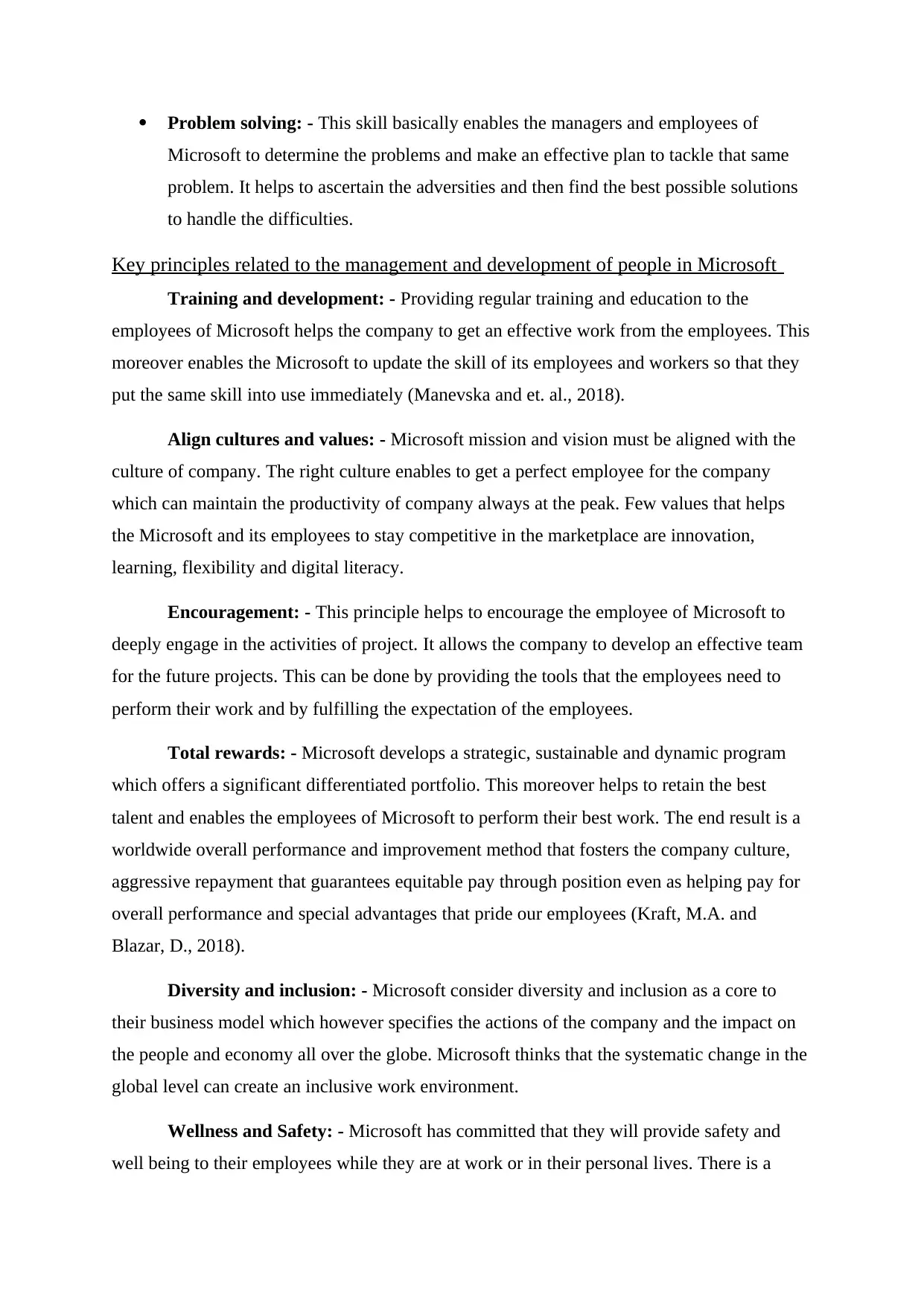
Problem solving: - This skill basically enables the managers and employees of
Microsoft to determine the problems and make an effective plan to tackle that same
problem. It helps to ascertain the adversities and then find the best possible solutions
to handle the difficulties.
Key principles related to the management and development of people in Microsoft
Training and development: - Providing regular training and education to the
employees of Microsoft helps the company to get an effective work from the employees. This
moreover enables the Microsoft to update the skill of its employees and workers so that they
put the same skill into use immediately (Manevska and et. al., 2018).
Align cultures and values: - Microsoft mission and vision must be aligned with the
culture of company. The right culture enables to get a perfect employee for the company
which can maintain the productivity of company always at the peak. Few values that helps
the Microsoft and its employees to stay competitive in the marketplace are innovation,
learning, flexibility and digital literacy.
Encouragement: - This principle helps to encourage the employee of Microsoft to
deeply engage in the activities of project. It allows the company to develop an effective team
for the future projects. This can be done by providing the tools that the employees need to
perform their work and by fulfilling the expectation of the employees.
Total rewards: - Microsoft develops a strategic, sustainable and dynamic program
which offers a significant differentiated portfolio. This moreover helps to retain the best
talent and enables the employees of Microsoft to perform their best work. The end result is a
worldwide overall performance and improvement method that fosters the company culture,
aggressive repayment that guarantees equitable pay through position even as helping pay for
overall performance and special advantages that pride our employees (Kraft, M.A. and
Blazar, D., 2018).
Diversity and inclusion: - Microsoft consider diversity and inclusion as a core to
their business model which however specifies the actions of the company and the impact on
the people and economy all over the globe. Microsoft thinks that the systematic change in the
global level can create an inclusive work environment.
Wellness and Safety: - Microsoft has committed that they will provide safety and
well being to their employees while they are at work or in their personal lives. There is a
Microsoft to determine the problems and make an effective plan to tackle that same
problem. It helps to ascertain the adversities and then find the best possible solutions
to handle the difficulties.
Key principles related to the management and development of people in Microsoft
Training and development: - Providing regular training and education to the
employees of Microsoft helps the company to get an effective work from the employees. This
moreover enables the Microsoft to update the skill of its employees and workers so that they
put the same skill into use immediately (Manevska and et. al., 2018).
Align cultures and values: - Microsoft mission and vision must be aligned with the
culture of company. The right culture enables to get a perfect employee for the company
which can maintain the productivity of company always at the peak. Few values that helps
the Microsoft and its employees to stay competitive in the marketplace are innovation,
learning, flexibility and digital literacy.
Encouragement: - This principle helps to encourage the employee of Microsoft to
deeply engage in the activities of project. It allows the company to develop an effective team
for the future projects. This can be done by providing the tools that the employees need to
perform their work and by fulfilling the expectation of the employees.
Total rewards: - Microsoft develops a strategic, sustainable and dynamic program
which offers a significant differentiated portfolio. This moreover helps to retain the best
talent and enables the employees of Microsoft to perform their best work. The end result is a
worldwide overall performance and improvement method that fosters the company culture,
aggressive repayment that guarantees equitable pay through position even as helping pay for
overall performance and special advantages that pride our employees (Kraft, M.A. and
Blazar, D., 2018).
Diversity and inclusion: - Microsoft consider diversity and inclusion as a core to
their business model which however specifies the actions of the company and the impact on
the people and economy all over the globe. Microsoft thinks that the systematic change in the
global level can create an inclusive work environment.
Wellness and Safety: - Microsoft has committed that they will provide safety and
well being to their employees while they are at work or in their personal lives. There is a
Paraphrase This Document
Need a fresh take? Get an instant paraphrase of this document with our AI Paraphraser
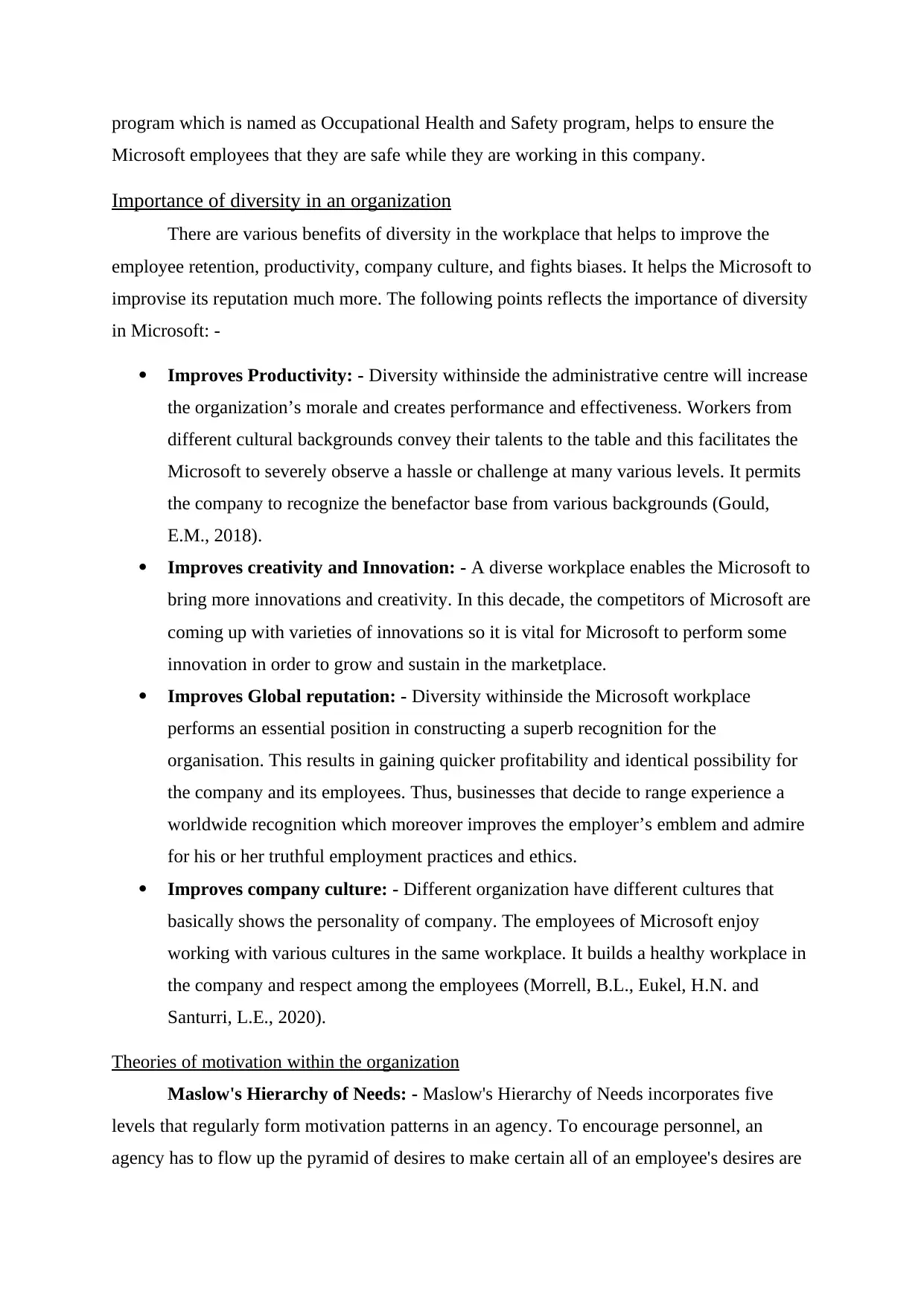
program which is named as Occupational Health and Safety program, helps to ensure the
Microsoft employees that they are safe while they are working in this company.
Importance of diversity in an organization
There are various benefits of diversity in the workplace that helps to improve the
employee retention, productivity, company culture, and fights biases. It helps the Microsoft to
improvise its reputation much more. The following points reflects the importance of diversity
in Microsoft: -
Improves Productivity: - Diversity withinside the administrative centre will increase
the organization’s morale and creates performance and effectiveness. Workers from
different cultural backgrounds convey their talents to the table and this facilitates the
Microsoft to severely observe a hassle or challenge at many various levels. It permits
the company to recognize the benefactor base from various backgrounds (Gould,
E.M., 2018).
Improves creativity and Innovation: - A diverse workplace enables the Microsoft to
bring more innovations and creativity. In this decade, the competitors of Microsoft are
coming up with varieties of innovations so it is vital for Microsoft to perform some
innovation in order to grow and sustain in the marketplace.
Improves Global reputation: - Diversity withinside the Microsoft workplace
performs an essential position in constructing a superb recognition for the
organisation. This results in gaining quicker profitability and identical possibility for
the company and its employees. Thus, businesses that decide to range experience a
worldwide recognition which moreover improves the employer’s emblem and admire
for his or her truthful employment practices and ethics.
Improves company culture: - Different organization have different cultures that
basically shows the personality of company. The employees of Microsoft enjoy
working with various cultures in the same workplace. It builds a healthy workplace in
the company and respect among the employees (Morrell, B.L., Eukel, H.N. and
Santurri, L.E., 2020).
Theories of motivation within the organization
Maslow's Hierarchy of Needs: - Maslow's Hierarchy of Needs incorporates five
levels that regularly form motivation patterns in an agency. To encourage personnel, an
agency has to flow up the pyramid of desires to make certain all of an employee's desires are
Microsoft employees that they are safe while they are working in this company.
Importance of diversity in an organization
There are various benefits of diversity in the workplace that helps to improve the
employee retention, productivity, company culture, and fights biases. It helps the Microsoft to
improvise its reputation much more. The following points reflects the importance of diversity
in Microsoft: -
Improves Productivity: - Diversity withinside the administrative centre will increase
the organization’s morale and creates performance and effectiveness. Workers from
different cultural backgrounds convey their talents to the table and this facilitates the
Microsoft to severely observe a hassle or challenge at many various levels. It permits
the company to recognize the benefactor base from various backgrounds (Gould,
E.M., 2018).
Improves creativity and Innovation: - A diverse workplace enables the Microsoft to
bring more innovations and creativity. In this decade, the competitors of Microsoft are
coming up with varieties of innovations so it is vital for Microsoft to perform some
innovation in order to grow and sustain in the marketplace.
Improves Global reputation: - Diversity withinside the Microsoft workplace
performs an essential position in constructing a superb recognition for the
organisation. This results in gaining quicker profitability and identical possibility for
the company and its employees. Thus, businesses that decide to range experience a
worldwide recognition which moreover improves the employer’s emblem and admire
for his or her truthful employment practices and ethics.
Improves company culture: - Different organization have different cultures that
basically shows the personality of company. The employees of Microsoft enjoy
working with various cultures in the same workplace. It builds a healthy workplace in
the company and respect among the employees (Morrell, B.L., Eukel, H.N. and
Santurri, L.E., 2020).
Theories of motivation within the organization
Maslow's Hierarchy of Needs: - Maslow's Hierarchy of Needs incorporates five
levels that regularly form motivation patterns in an agency. To encourage personnel, an
agency has to flow up the pyramid of desires to make certain all of an employee's desires are
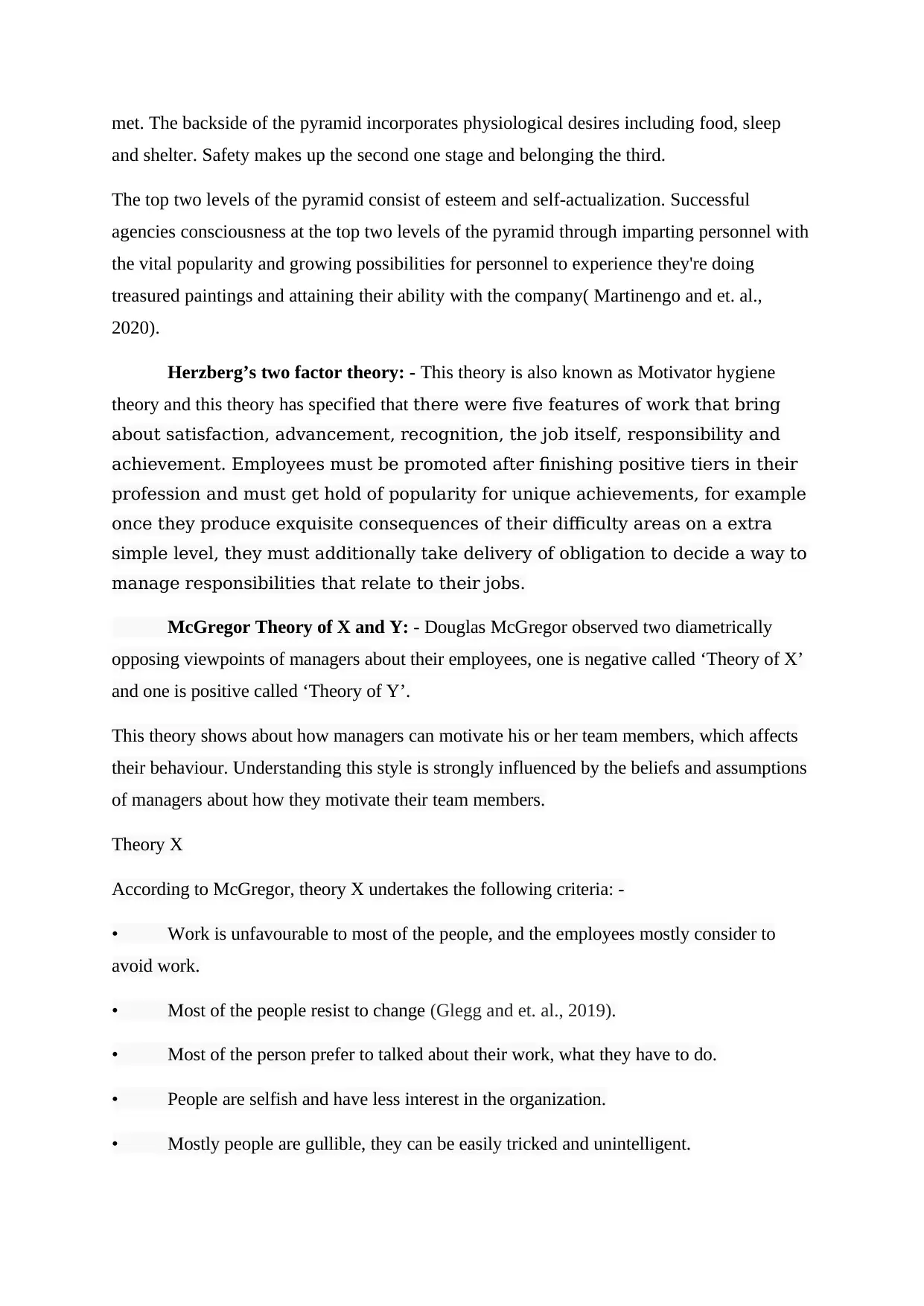
met. The backside of the pyramid incorporates physiological desires including food, sleep
and shelter. Safety makes up the second one stage and belonging the third.
The top two levels of the pyramid consist of esteem and self-actualization. Successful
agencies consciousness at the top two levels of the pyramid through imparting personnel with
the vital popularity and growing possibilities for personnel to experience they're doing
treasured paintings and attaining their ability with the company( Martinengo and et. al.,
2020).
Herzberg’s two factor theory: - This theory is also known as Motivator hygiene
theory and this theory has specified that there were five features of work that bring
about satisfaction, advancement, recognition, the job itself, responsibility and
achievement. Employees must be promoted after finishing positive tiers in their
profession and must get hold of popularity for unique achievements, for example
once they produce exquisite consequences of their difficulty areas on a extra
simple level, they must additionally take delivery of obligation to decide a way to
manage responsibilities that relate to their jobs.
McGregor Theory of X and Y: - Douglas McGregor observed two diametrically
opposing viewpoints of managers about their employees, one is negative called ‘Theory of X’
and one is positive called ‘Theory of Y’.
This theory shows about how managers can motivate his or her team members, which affects
their behaviour. Understanding this style is strongly influenced by the beliefs and assumptions
of managers about how they motivate their team members.
Theory X
According to McGregor, theory X undertakes the following criteria: -
• Work is unfavourable to most of the people, and the employees mostly consider to
avoid work.
• Most of the people resist to change (Glegg and et. al., 2019).
• Most of the person prefer to talked about their work, what they have to do.
• People are selfish and have less interest in the organization.
• Mostly people are gullible, they can be easily tricked and unintelligent.
and shelter. Safety makes up the second one stage and belonging the third.
The top two levels of the pyramid consist of esteem and self-actualization. Successful
agencies consciousness at the top two levels of the pyramid through imparting personnel with
the vital popularity and growing possibilities for personnel to experience they're doing
treasured paintings and attaining their ability with the company( Martinengo and et. al.,
2020).
Herzberg’s two factor theory: - This theory is also known as Motivator hygiene
theory and this theory has specified that there were five features of work that bring
about satisfaction, advancement, recognition, the job itself, responsibility and
achievement. Employees must be promoted after finishing positive tiers in their
profession and must get hold of popularity for unique achievements, for example
once they produce exquisite consequences of their difficulty areas on a extra
simple level, they must additionally take delivery of obligation to decide a way to
manage responsibilities that relate to their jobs.
McGregor Theory of X and Y: - Douglas McGregor observed two diametrically
opposing viewpoints of managers about their employees, one is negative called ‘Theory of X’
and one is positive called ‘Theory of Y’.
This theory shows about how managers can motivate his or her team members, which affects
their behaviour. Understanding this style is strongly influenced by the beliefs and assumptions
of managers about how they motivate their team members.
Theory X
According to McGregor, theory X undertakes the following criteria: -
• Work is unfavourable to most of the people, and the employees mostly consider to
avoid work.
• Most of the people resist to change (Glegg and et. al., 2019).
• Most of the person prefer to talked about their work, what they have to do.
• People are selfish and have less interest in the organization.
• Mostly people are gullible, they can be easily tricked and unintelligent.
⊘ This is a preview!⊘
Do you want full access?
Subscribe today to unlock all pages.

Trusted by 1+ million students worldwide

• People have little creativity in solving the organization problems.
Theory Y
In strong contrast to the above theory of McGregor that is Theory X, Theory Y management
makes the following expectations:
• In this theory, most people like to do the work.
• People here drive themselves and work effectively for the organization.
• Most people consist themselves to the objectives and take the initiative to grab the
opportunities (Raibulet, C. And Fontana, F.A., 2018).
• The creativity spreads very fast in the organization comparatively to the above theory
of McGregor.
• People are very intelligent and creative to do their work.
Equity Theory of employee motivation: - John Stacey Adams Equity Theory claims
that employees are influenced once they understand their remedy withinside the place of job
to be truthful and unmotivated while remedy is appeared to be unfair. In an organization, this
entails supplying employees with reputation for the activities they're doing and giving all
employees the risk to develop or earn bonuses and awards. Managers who play favourites or
single out personnel for reputation can also additionally face a in large part in unmotivated
organization of personnel.
From the above theories of motivation, it has been concluded that Microsoft majorly applies
the Herzberg’s two factor theory to employees which helps them to motivate its employees
and get an efficient work.
Theories of decision making and problem solving in Microsoft
Decision making theory: - Decision making theory is a concept of ways rational
people must behave below threat and uncertainty. It makes use of a fixed of axioms
approximately how rational people must behave which has been broadly challenged on each
experimental and theoretical ground. It basically states the choices of making an effective
decision from the various course of actions. It plays a vital role in Microsoft planning
process, whenever a manager makes a plan, they have to go through a lot of situations and
Theory Y
In strong contrast to the above theory of McGregor that is Theory X, Theory Y management
makes the following expectations:
• In this theory, most people like to do the work.
• People here drive themselves and work effectively for the organization.
• Most people consist themselves to the objectives and take the initiative to grab the
opportunities (Raibulet, C. And Fontana, F.A., 2018).
• The creativity spreads very fast in the organization comparatively to the above theory
of McGregor.
• People are very intelligent and creative to do their work.
Equity Theory of employee motivation: - John Stacey Adams Equity Theory claims
that employees are influenced once they understand their remedy withinside the place of job
to be truthful and unmotivated while remedy is appeared to be unfair. In an organization, this
entails supplying employees with reputation for the activities they're doing and giving all
employees the risk to develop or earn bonuses and awards. Managers who play favourites or
single out personnel for reputation can also additionally face a in large part in unmotivated
organization of personnel.
From the above theories of motivation, it has been concluded that Microsoft majorly applies
the Herzberg’s two factor theory to employees which helps them to motivate its employees
and get an efficient work.
Theories of decision making and problem solving in Microsoft
Decision making theory: - Decision making theory is a concept of ways rational
people must behave below threat and uncertainty. It makes use of a fixed of axioms
approximately how rational people must behave which has been broadly challenged on each
experimental and theoretical ground. It basically states the choices of making an effective
decision from the various course of actions. It plays a vital role in Microsoft planning
process, whenever a manager makes a plan, they have to go through a lot of situations and
Paraphrase This Document
Need a fresh take? Get an instant paraphrase of this document with our AI Paraphraser

then decide what to do. The quality of the decision has a large impact on the effectiveness of
the plan made by the manager.
Problem solving theory: - This theory involves the process of identifying the goals
and then use strategic methods to reach that same goal. It enables the Microsoft to observe
what is going on the workplace and identify the things that could help to improvise the
functionality of operations in the workplace. This theory is majorly used by Microsoft when
the company is facing a lot of adversities and the company want to get an effective solution
for the problem (Shakina and et. al., 2021).
Conclusion
From the above report, it has been concluded that management skills are very much
important for an organization as well as the key principles that is related to managing and
developing the employees of Microsoft. It has also been analysed that how diversity in an
organization helps them to perform an effective and how it helps to keep a stable and happy
workplace. The various theories of motivation are also discussed in which it has been
analysed that Microsoft majorly used Herzberg’s two factor theory to employees that enables
the company to motivate its employees and get an efficient work. Moreover, the theories of
decision making as well as problem solving in context with Microsoft are also discussed.
References
Klein, J.D. and Kelly, W.Q., 2018. Competencies for instructional designers: A view from
employers. Performance Improvement Quarterly, 31(3), pp.225-247.
Shah, S., Gochtovtt, A. And Baldini, G., 2019. Importance of project management in business
analytics: academia and real world. In Aligning business strategies and analytics (pp. 81-94).
Springer, Cham.
Manevska and et. al., 2018. Bridging the gap between university curriculum and industrial
needs: A case study of teaching interpersonal skills. International Journal of Organizational
Leadership, 7(1), pp.61-70.
Kraft, M.A. and Blazar, D., 2018. Taking teacher coaching to scale: Can personalized
training become standard practice?. Education Next, 18(4), pp.68-75.
Gould, E.M., 2018. Workflow management tools for electronic resources
management. Serials review, 44(1), pp.71-74.
Morrell, B.L., Eukel, H.N. and Santurri, L.E., 2020. Soft skills and implications for future
professional practice: Qualitative findings of a nursing education escape room. Nurse
Education Today, 93, p.104462.
the plan made by the manager.
Problem solving theory: - This theory involves the process of identifying the goals
and then use strategic methods to reach that same goal. It enables the Microsoft to observe
what is going on the workplace and identify the things that could help to improvise the
functionality of operations in the workplace. This theory is majorly used by Microsoft when
the company is facing a lot of adversities and the company want to get an effective solution
for the problem (Shakina and et. al., 2021).
Conclusion
From the above report, it has been concluded that management skills are very much
important for an organization as well as the key principles that is related to managing and
developing the employees of Microsoft. It has also been analysed that how diversity in an
organization helps them to perform an effective and how it helps to keep a stable and happy
workplace. The various theories of motivation are also discussed in which it has been
analysed that Microsoft majorly used Herzberg’s two factor theory to employees that enables
the company to motivate its employees and get an efficient work. Moreover, the theories of
decision making as well as problem solving in context with Microsoft are also discussed.
References
Klein, J.D. and Kelly, W.Q., 2018. Competencies for instructional designers: A view from
employers. Performance Improvement Quarterly, 31(3), pp.225-247.
Shah, S., Gochtovtt, A. And Baldini, G., 2019. Importance of project management in business
analytics: academia and real world. In Aligning business strategies and analytics (pp. 81-94).
Springer, Cham.
Manevska and et. al., 2018. Bridging the gap between university curriculum and industrial
needs: A case study of teaching interpersonal skills. International Journal of Organizational
Leadership, 7(1), pp.61-70.
Kraft, M.A. and Blazar, D., 2018. Taking teacher coaching to scale: Can personalized
training become standard practice?. Education Next, 18(4), pp.68-75.
Gould, E.M., 2018. Workflow management tools for electronic resources
management. Serials review, 44(1), pp.71-74.
Morrell, B.L., Eukel, H.N. and Santurri, L.E., 2020. Soft skills and implications for future
professional practice: Qualitative findings of a nursing education escape room. Nurse
Education Today, 93, p.104462.
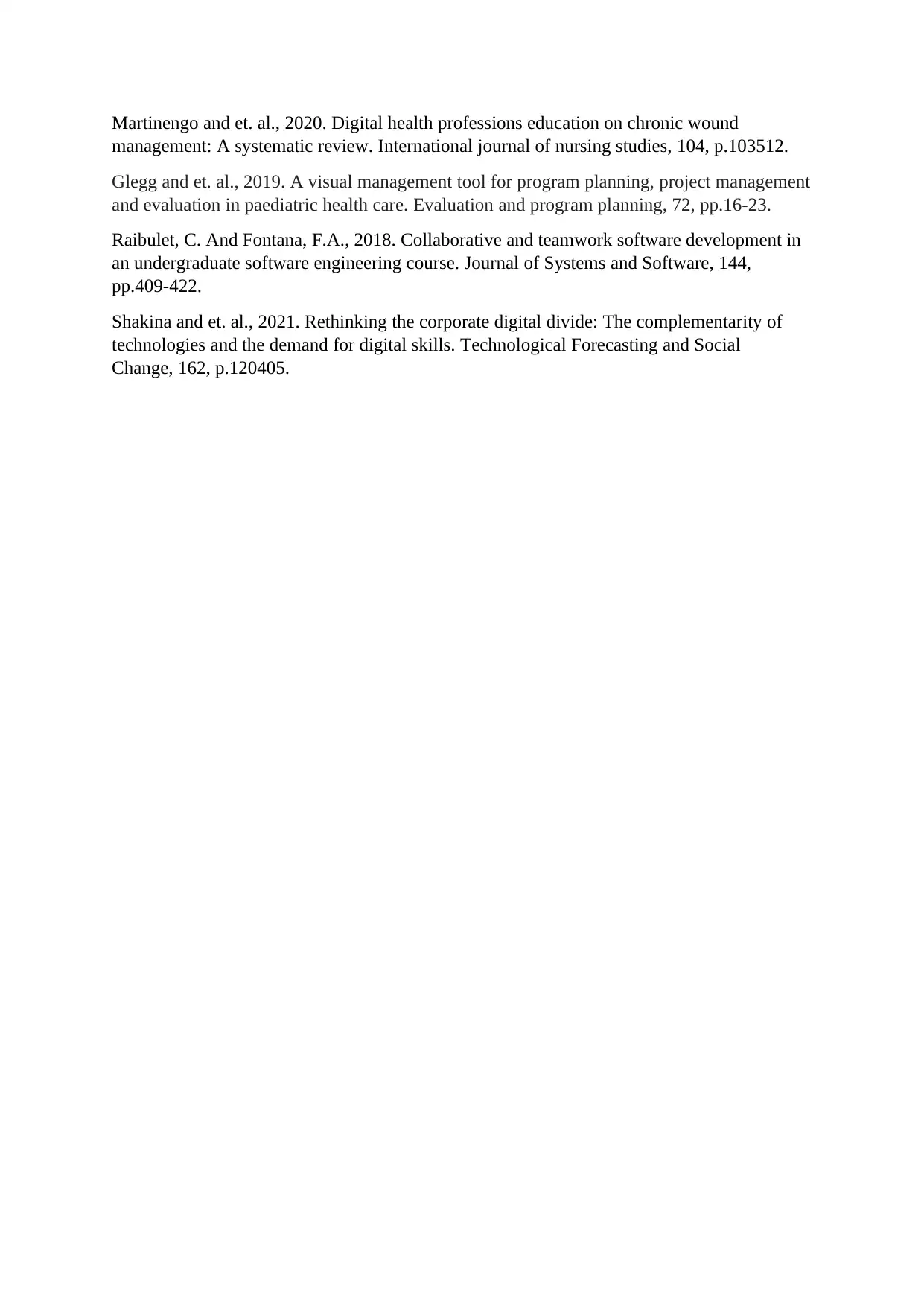
Martinengo and et. al., 2020. Digital health professions education on chronic wound
management: A systematic review. International journal of nursing studies, 104, p.103512.
Glegg and et. al., 2019. A visual management tool for program planning, project management
and evaluation in paediatric health care. Evaluation and program planning, 72, pp.16-23.
Raibulet, C. And Fontana, F.A., 2018. Collaborative and teamwork software development in
an undergraduate software engineering course. Journal of Systems and Software, 144,
pp.409-422.
Shakina and et. al., 2021. Rethinking the corporate digital divide: The complementarity of
technologies and the demand for digital skills. Technological Forecasting and Social
Change, 162, p.120405.
management: A systematic review. International journal of nursing studies, 104, p.103512.
Glegg and et. al., 2019. A visual management tool for program planning, project management
and evaluation in paediatric health care. Evaluation and program planning, 72, pp.16-23.
Raibulet, C. And Fontana, F.A., 2018. Collaborative and teamwork software development in
an undergraduate software engineering course. Journal of Systems and Software, 144,
pp.409-422.
Shakina and et. al., 2021. Rethinking the corporate digital divide: The complementarity of
technologies and the demand for digital skills. Technological Forecasting and Social
Change, 162, p.120405.
⊘ This is a preview!⊘
Do you want full access?
Subscribe today to unlock all pages.

Trusted by 1+ million students worldwide
1 out of 9
Related Documents
Your All-in-One AI-Powered Toolkit for Academic Success.
+13062052269
info@desklib.com
Available 24*7 on WhatsApp / Email
![[object Object]](/_next/static/media/star-bottom.7253800d.svg)
Unlock your academic potential
Copyright © 2020–2025 A2Z Services. All Rights Reserved. Developed and managed by ZUCOL.




